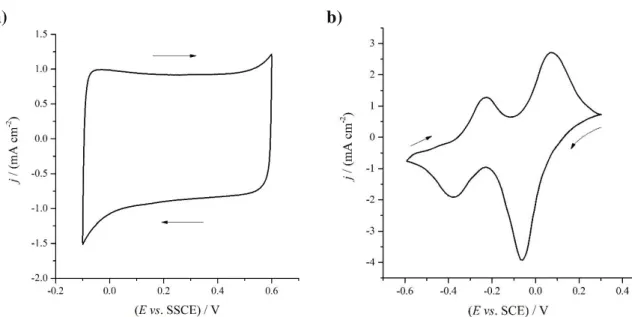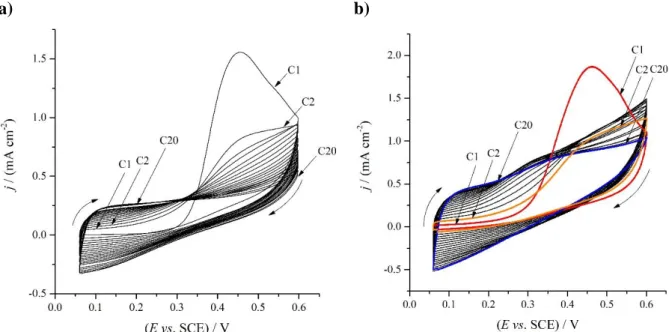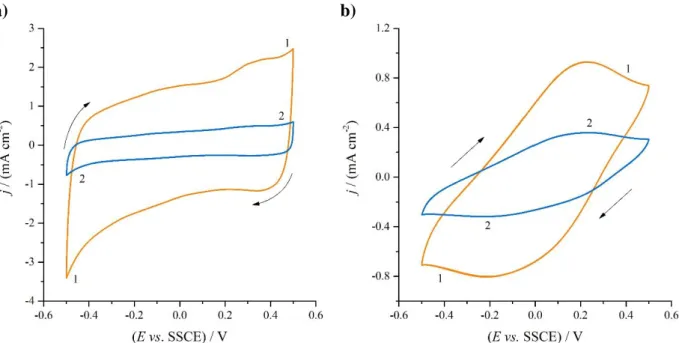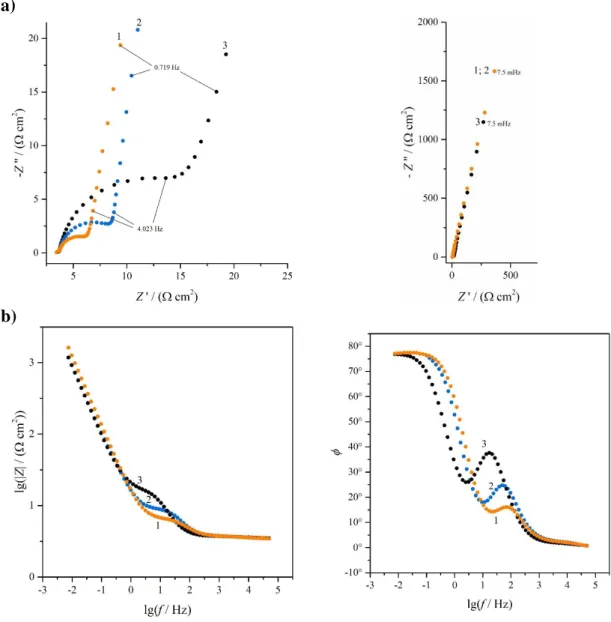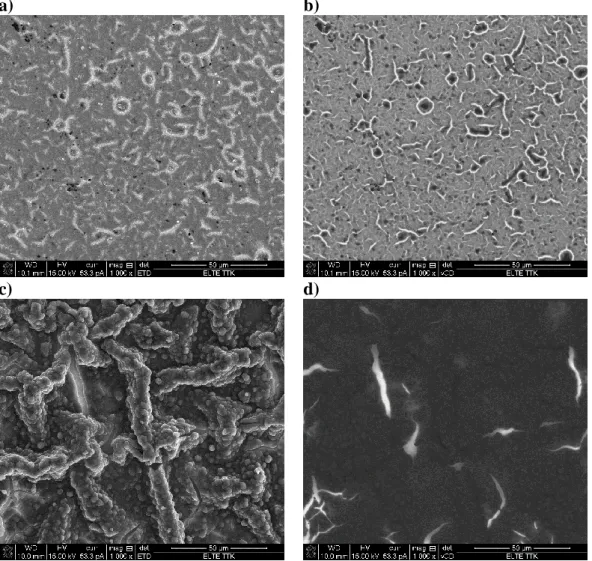1
Short communication
Investigation of the electrochemical properties of poly(3,4-ethylenedioxypyrrole) films electrodeposited from aqueous solutions
Krisztina J. Szekeres1,*, Kristóf Hegedüs2, Mária Ujvári1, Gyözö G. Láng1
1Department of Physical Chemistry&Laboratory of Electrochemistry and Electroanalytical Chemistry, Institute of Chemistry, Eötvös Loránd University, Pázmány Péter sétány 1/A, 1117 Budapest, Hungary
2Institute of Organic Chemistry, Hungarian Academy of Sciences, Research Centre for Natural Sciences, Magyar tudósok körútja 2A, 1117 Budapest, Hungary
ABSTRACT:
Poly(3,4-ethylenedioxypyrrole) films on gold substrate were prepared by electropolymerization of ethylenedioxypyrrole monomer (EDOP) under potentiodynamic conditions in aqueous sodium sulfate solutions. The aim of the work was to characterize the gold|poly(3,4- ethylenedioxypyrrole) electrodes in aqueous sulfuric acid solutions and to compare the results with those of other studies that investigated similar systems. However, the experimental results obtained for the PEDOP modified electrodes significantly deviated from the expectations based on studies with similar systems. According to the results, two distinct types of polymer films were formed depending on the storage history of the monomer solutions. By using “fresh”
monomer solutions polymer films with nearly ideal capacitive behavior were obtained and almost rectangular-shaped cyclic voltammograms could be observed in a rather broad potential range. Impedance spectra revealed that the charge transfer resistance between the substrate and the film was low. According to the SEM images the polymer layer on the gold substrate was relatively smooth with some small and short cracks. In contrast, working with “old” monomer solution that was not properly stored, the shapes of the cyclic voltammograms recorded at the Au | PEDOP | 0.1 M sulfuric acid (aq.) electrode exhibited two peaks, a reduction peak at about -0.2 V vs. SSCE and an oxidation peak close to 0.2 V vs. SSCE, and the charge transfer resistances were considerably higher than those estimated for the electrode prepared using
“fresh” monomer solutions. SEM images showed that the surface of the polymer film was extremely rough, with several wrinkles, creases and large cracks. This behavior was quite unexpected, because the two types of samples were prepared in the same way and only the storage histories of the two commercial monomer solutions were different.
* Corresponding author, Department of Physical Chemistry&Laboratory of Electrochemistry and Electroanalytical Chemistry, Institute of Chemistry, Eötvös Loránd University, Pázmány Péter sétány 1/A, 1117 Budapest, Hungary
E-mail address: szekkriszt@caesar.elte.hu
2
Keywords: conducting polymers, PEDOP, electropolymerization, cyclic voltammetry, impedance spectroscopy, scanning electron microscopy
1. Introduction
After more than four decades of research in the field of electrochemically active, electronically conducting polymeric systems, the preparation, characterization and application of such systems are still the research interests of many electrochemists [1,2].
The interest in these systems is mainly two-fold: first, they have exciting possibilities for a wide range of practical applications (e.g. in the fields of electrocatalysis, electroanalysis, energy storage, bioelectrochemistry, medical applications, photoelectrochemistry, sensors, electro- chromic displays, microwave screening and corrosion protection, etc.) second is the intellectual curiosity of scientists to understand the electrochemical behavior of the polymers including the mechanism of charge transfer and charge transport processes that occur during redox reactions of conducting polymeric materials [3,4,5].
Conductive polymers can be classified into different categories according to the mode of charge propagation, which is linked to the chemical structure of the polymer. The two main categories are electron-conducting polymers and ion (proton)-conducting polymers [1,6].
Sulfonated polystyrene, polyaryl ketone, polyaryl sulfone are examples for the latter type of polymers in which the conduction of electricity is due to the transfer of protons. Nevertheless, the ionically conducting polymers (polymer electrolytes and polyelectrolytes) may also belong to this category.
The other group, i.e. the electron-conducting polymers can be further classified on the basis of mode of electron transport. According to generally accepted theories the transport of electrons can be assumed to occur via an electron exchange reaction (electron hopping) between neighboring redox sites (in the so called “redox polymers”, examples for this group are poly(tetracyanoquinodimethane) (PTCNQ), poly(viologens), some organometallic redox polymers, etc.), and by the movement of delocalized electrons through conjugated systems in the case of so-called intrinsically conducting polymers (ICPs, e.g. polyaniline, polypyrrole, polythiophene, and their derivatives, e.g. poly(3,4-ethylenedioxythiophene) (PEDOT)). Redox polymers can be divided into several subclasses. Polymers contain covalently attached redox sites, either built into the chain, or as pendant groups; the redox centers are mostly organic or
3
organometallic molecules and ion-exchange polymeric systems (polyelectrolytes) where the redox active ions (mostly complex compounds) are held by electrostatic binding.
In the case of ICPs the motion of delocalized electrons occurs through conjugated systems (electron displacement); however, the electron hopping mechanism is likely to be operative as well, especially between chains (interchain conduction) and defects. Electrochemical transformations usually lead to a reorganization of the bonds of the polymers prepared by oxidative or less frequently reductive polymerization of benzoid or nonbenzoid (mostly amines) and heterocyclic compounds. In almost every case, the charge is also carried by the movement of electroinactive ions during electrolysis; in other words, in electrochemical systems these materials (i.e. redox polymers and ICPs) constitute mixed conductors [1]. A simple distinction between the intrinsically conducting and redox polymers is that in dry state the ICPs are conducting while redox polymers have high electrical resistance [2,3]. This is simply due to the fact that redox polymers and ionically conducting polymers need a liquid (water or other solvent) which acts as a plasticizer and makes the chain and segmental motions possible. It is also known that for intrinsically conducting polymers with high conjugation lengths nearly ideal capacitive behavior and “rectangular-shaped” cyclic voltammograms can be observed in a rather broad potential range [7]. The shapes of these curves are quite different from the shapes of cyclic voltammograms recorded for redox polymer modified electrodes where peaks (one or more minima and maxima) related to redox processes can be observed (see Fig.1, in which cyclic voltammograms recorded at PEDOT (similar to those published in ref. [8]) and PTCNQ modified electrodes [9,10] are shown).
Poly(3,4-ethylenedioxypyrrole) (PEDOP) belongs to the family of conducting polymers with high electronic conductivity, controllable optoelectronic and redox properties. The alkylenedioxy substitution pattern serves to enhance the electrochemical, optical, and electrochromic properties of the polypyrrole backbone in a manner that is analogous to that observed for PEDOT [11]. PEDOP has a fairly low oxidation potential (half wave potential (E1/2) of about –0.3 vs. SCE), therefore this polymer is one of the most easily oxidized conducting polymers. In addition, PEDOP shows outstanding redox stability upon potential cycling [11]. The advantageous properties of PEDOP allow it to be used in a variety of applications including solar cells, smart windows, color sensors, biosensors, or other biological systems [12,13,14,15,16]. Nevertheless, the scientific literature published on PEDOP [17,18,19,20], with special regard to its electrochemical behavior is much less compared to that of other conducting polymers [21].
4
Encouraged by the above facts we tried to obtain poly(3,4-ethylenedioxypyrrole) films on gold (modified electrodes) for electrochemical experiments by electropolymerization of the ethylenedioxypyrrole monomer (EDOP), under potentiodynamic conditions in aqueous sodium sulfate solutions. The aim of this work was twofold: (a) to characterize the gold|poly(3,4- ethylenedioxypyrrole) electrodes in aqueous sulfuric acid solutions (this system is assumed to be suitable for specific practical applications) (b) to compare the results with those of other studies that investigated similar systems (e.g. polypyrrole films [22]).
However, the experimental results obtained for the modified electrodes in contact with sulfuric acid solutions significantly deviated from those expected based on studies with similar system types. The purpose of this short communication is to present the most interesting results obtained so far for this systems.
2. Experimental
2.1. Instruments
A Metrohm Autolab PGSTAT 302N potentiostat (controlled by the Autolab Nova software) and a Zahner IM6 electrochemical workstation (controlled by the Thales software package) was used in all electrochemical experiments.
a) b)
Figure 1. Cyclic voltammograms of a Au|Poly(3,4-ethylenedioxythiophene) electrode in contact with 0.1 mol·dm−3 aqueous solution of H2SO4, scan rate ν = 50 mV·s−1, E = –0.1 – 0.6 V vs. SSCE (a), and a Pt|poly(tetracyanoquinodimethane) electrode in contact with 10 mol·dm−3 aqueous solution of LiCl, scan rate ν = 4 mV·s−1, E = –0.6 – 0.3 V vs. SCE (b).
5
A Quanta™ 3D FEG high-resolution dual beam scanning electron microscopy (SEM/FIB) instrument was used for SEM analysis.
2.2. Solutions
Cyclic voltammetry and impedance measurements were carried out in aqueous solutions.
According to [23] the aqueous medium facilitates EDOP polymerization. For this reason the polymerization was performed in aqueous solutions as well. All these solutions were prepared using ultra-pure water (specific resistance 18.3 MΩ·cm−1). The solutions were purged with oxygen-free argon (Linde 5.0) before use, and an inert gas blanket was maintained throughout the experiments.
2.3. Electrodeposition of poly(3,4-ethylenedioxypyrrole)
Several batches of the EDOP monomer solution was purchased from Sigma-Aldrich (2 % (w/v) in THF). Before the preparation of the aqueous solutions the organic solvent (THF) was removed by vacuum distillation.
A portion of the EDOP monomer was used for the preparation of the PEDOP layers immediately after the material was received from Sigma-Aldrich, i.e. the aqueous solution used for the polymerization process contained 0.01 mol dm−3 “fresh” 3,4-ethylenedioxypyrrole + 0.1 mol dm−3 Na2SO4 (“solution #1”).
“Solution #2” was prepared using the EDOP monomer in THF solution six months after its arrival. The EDOP solution was kept in the refrigerator at about 4 C until use.
The Au|poly(3,4-ethylenedioxypyrrole) (Au|PEDOP) films for electrochemical experiments were prepared by electropolymerization from 0.01 mol dm−3 3,4- ethylenedioxypyrrole (Sigma-Aldrich) + 0.1 mol dm−3 Na2SO4 (Fluka) solutions under potentiodynamic conditions. The depositions were carried out in a standard three electrode cell in which the Au (A = 0.2 cm2) plate in contact with the solution served as the working electrode (WE). A gold ring (a circular Au wire) immersed in the same solution served as the counter electrode (CE), and a KCl-saturated calomel electrode (SCE) as the reference electrode (RE).
The PEDOP films were formed on gold plates (scan rate: 10 mV·s−1, 20 polymerization cycles) in the range of 0.06–0.60 V vs. SCE.
Cyclic voltammograms recorded during the electropolymerization of PEDOT films from solution#1 and solution #2 are shown in Fig. 2. (The resulting two modified electrodes will be referred to as “electrode A” and “electrode B” henceforth in this manuscript.)
6
After electrodeposition of the films, the PEDOP coated gold plates were rinsed with deionized water to remove monomer molecules.
2.4. Cyclic voltammetry and impedance measurements
In the conventional three-electrode cell configuration the PEDOP-modified gold substrate in contact with 0.1 mol·dm−3 H2SO4 solution (analytical grade, Merck) was used as the working electrode (WE), and a NaCl-saturated calomel electrode (SSCE) as the reference electrode (RE). A high surface area cylindrical gold-foil (immersed in the same solution) was arranged cylindrically around the working electrode to maintain a uniform electric field and served as counter electrode (CE). Cyclic voltammetric curves were recorded in the potential range of ‒ 0.5 V to 0.5 V vs. SSCE at different sweep rates (e.g. 10 and 50 mV/s).
Impedance measurements were performed at 67 discrete frequencies in the frequency range of 0.0075 Hz–50 kHz at an amplitude of 5 mV rms.
3. Results and discussion
3.1. Cyclic voltammetry
Cyclic voltammetric curves recorded at a gold | PEDOP | 0.1 M sulfuric acid (aq) electrode prepared from solution #1 (electrode A) at sweep rates of ν=10 and 50 mV s−1 are presented in
a) b)
Figure 2. Potentiodynamic electropolymerization of PEDOP film on Au plates (geometric surface area A = 0.2 cm2) from 0.01 mol·dm−3 EDOP / 0.1 mol·dm−3 Na2SO4 aqueous solution. ν = 10 mV·s−1; E = 60 – 600 mV vs. SCE. The number of cycles was 20. a) Solution #1. b) Solution #2.
7
Fig. 3a. In the potential interval −0.5–0.5 V vs. SSCE the PEDOP films are remarkably stable, retaining their properties even after several consecutive cyclic voltammetric scans. This finding is in good agreement with the results reported by Gaupp et. al. [11], where PEDOP modified electrodes were found to have outstanding redox stability upon potential cycling in 0.1 M LiClO4 (propylene carbonate) solution. On the other hand, a nearly ideal capacitive behavior and almost rectangular-shaped cyclic voltammograms could be observed in the potential range of −0.5–0.5 V vs. SSCE. This is not too surprising (although we could not find similar results in previous work), when one considers that under identical conditions gold | PEDOT | sulfuric acid(aq) electrodes (containing PEDOT films electrodeposited from aqueous solutions) exhibit [7,8,24,25] very similar behavior.
In contrary, the shapes of the cyclic voltammograms recorded at the gold | PEDOP | 0.1 M sulfuric acid (aq) electrode prepared from solution #2 (electrode B, see Fig. 3b) differs considerably from the shapes of the CV-s shown in Fig. 3a. The curves have two peaks, a reduction peak at about –0.2 V vs. SSCE and an oxidation peak close to 0.2 V vs. SSCE.
This behavior was quite unexpected, because the two samples were prepared in the same way and only the storage histories of the two commercial monomer solutions were different.
3.2. Impedance measurements and scanning electron microscopy
a) b)
Figure 3. Cyclic voltammograms of the Au|PEDOP electrodes ( a) electrode A b) electrode B ) recorded in 0.1 mol·dm−3 aqueous H2SO4 solutions at different scan rates: (1) ν = 50 mV·s−1; (2) ν = 10 mV·s−1. E = –0.5 – 0.5 mV vs. SSCE. The 2. scans are showed.
8
In Figs. 4 and 5 impedance spectra of Au | PEDOP | 0.1 M sulfuric acid electrodes recorded at three different electrode potentials (–0.3 V, 0 V and 0.5 V vs. SSCE) are shown.
The impedance spectra of electrode A revealed that the charge transfer resistance between the substrate and the film was quite low (the diameter of the high frequency semicircle in the complex plane impedance plot varied between 5 and 20 Ω, depending on the electrode potential, see Fig. 4a). According to the SEM images (Figs. 6a and 6b) the polymer layer on the gold substrate was relatively smooth with some small and short cracks. This result is in good agreement with the finding that aqueous environment facilitates the formation of smooth and homogeneous PEDOP films [23].
a)
b)
Figure 4. Impedance spectra of the Au|PEDOP electrode A in contact with 0.1 mol·dm−3 H2SO4 aqueous solution at potentials: (1) E = –0.3 V; (2) E = 0.0 V and (3) E = 0.5 V vs.
SSCE. Small numbers refer to values of the frequency. a) Complex plane plot; b) Bode plots.
9
On the other hand, at the corresponding electrode potentials the charge transfer resistances in the case of electrode B appear to be considerably higher than those estimated for electrode A. According to Fig. 5a the diameter of the high-frequency arc in the complex plane impedance diagram varies between 70 and 700 Ω., since as it can be seen in the SEM images shown in Figs. 6c and 6d the surface of the polymer film contacting with the electrolyte solution is extremely rough and rugged, with several wrinkles, creases and large cracks, but some filament- like structures can also be observed.
What can be the reason of this behavior?
a)
b)
Figure 5. Impedance spectra of the Au|PEDOP electrode B in contact with 0.1 mol·dm−3 H2SO4 aqueous solution at potentials: (1) E = –0.3 V; (2) E = 0.0 V and (3) E = 0.5 V vs.
SSCE. Small numbers refer to values of the frequency. a) Complex plane plot; b) Bode plots.
10
The answer does not seem to be simple. Since electrode A and electrode B were prepared under identical conditions the observed significant differences in morphology and electrochemical behavior can only be attributed to differences in the properties of the monomer solutions. Therefore, the solutions used for film deposition was investigated with high- performance liquid chromatography-mass spectrometry (HPLC–MS). In case of solution #1 no other peaks than those originating from the solvent and the EDOP monomer could be observed in the chromatograms. On the other hand, according to HPLC-MS analyses solution #2 contained considerable amounts of dimers and oligomers in addition to the monomer and solvent molecules. The dimers and oligomers were formed most probably by spontaneous dimerization and polymerization during the improper storage of the monomer solution. The presence of dimers and oligomers in the solution may strongly influence the polymerization mechanism.
a) b)
c) d)
Figure 6. SEM images of electrode A: a), b) and electrode B: c), d). Secondary electron SEM images: a), c) and the corresponding backscattered SEM images: b), d) taken from the same area. The length of the horizontal white bar below the images corresponds to 50 µm.
11
It is known that despite some differences in interpretation of literature results on the electropolymerization of monomers and oligomers, there seems to be a general consensus that long conjugated oligomers are poorly (if at all) electropolymerizable because of the increased stabilization of their extended cation radicals, which prevents further coupling toward the formation of polymers [1,26,27,28]. Nevertheless, it has been shown e.g. in [28] that “extending oligothiophene length beyond certain limit apparently brings them to an “island of reactivity”
toward electropolymerization”. On the other hand, the conjugation length of the polymer chains, which is a primary indicator of conductivity, may also be influenced by oligomerization.
It is known that rather short conjugation lengths are usually sufficient for reasonable conductivity [29]. Intuitively, conjugation should be important in two respects. First, carrier generation upon oxidation or reduction should be facilitated with high conjugation lengths since the resulting radical cation or anion will be more highly delocalized. Second, higher conjugation lengths ought to facilitate intermolecular charge transport by providing more frequent π-π overlap between adjacent backbones.
Nevertheless, it is clear from our results, that the conjugation length is longer in the case of the PEDOP film prepared from “fresh” monomer solution.
4. Conclusions
Unfortunately, with limited experimental data available, no final conclusion regarding the reasons for this unusual electrochemical behavior of the PEDOP modified electrodes can be drawn at this time, and more experiments will have to be done to gain better understanding of the observed phenomena. The above results indicate that the conjugation length increases if the time interval between the preparation of the monomer and the electropolymerization experiment is shorter. It would be very interesting e.g. to know what happens and which type of film is formed when freshly synthetized (and not “freshly purchased”) monomer is used in the electropolymerization process. Nevertheless, the synthesis of EDOP seems to be quite complicated (8 to 10 steps, see e.g. [30] and references therein).
The characterization and analysis of polymer modified electrodes presented here could be of value in the design and preparation of such electrochemically responsive systems for a range of applications requiring a high degree of stability and tunability, including their use as polymer matrix in supercapacitors or in composite materials.
12 Acknowledgment:
Supported by the ÚNKP-17-3 New National Excellence Program of the Ministry of Human Capacities. Support from the Hungarian Scientific Research Fund - OTKA, the National Research, Development and Innovation Office – NKFI (grant No. K 109036) is gratefully acknowledged. The research within project No. VEKOP-2.3.2-16-2017-00013 by G.G. Láng was supported by the European Union and the State of Hungary, co-financed by the European Regional Development Fund.
13
References
[1] G. Inzelt, Conducting polymers: a new era in electrochemistry, Springer, Berlin, Heidelberg, 2012.
doi:10.1007/978-3-540-75930-0.
[2] G. Inzelt, Recent advances in the field of conducting polymers, Journal of Solid State Electrochemistry. 21 (2017) 1965–1975. doi:10.1007/s10008-017-3611-6.
[3] G. Inzelt, Conducting polymers: past, present, future, Journal of Electrochemical Science and Engineering.
8 (2018) 3–37. doi:10.5599/jese.448.
[4] J.G. Ibanez, M.E. Rincón, S. Gutierrez-Granados, M. Chahma, O.A. Jaramillo-Quintero, B.A. Frontana- Uribe, Conducting Polymers in the Fields of Energy, Environmental Remediation, and Chemical-Chiral Sensors, Chemical Reviews. 118 (2018) 4731–4816. doi:10.1021/acs.chemrev.7b00482.
[5] Ricardo Tucceri, Poly(o-aminophenol) Film Electrodes Synthesis, Transport Properties and Practical Applications, Engineering Materials, Springer International Publishing Switzerland, 2013.
doi:10.1007/978-3-319-02114-0_1.
[6] Pradip Kar, Doping in cojugated polymers, Scrivener Publishing LLC, Beverly, MA, Wiley, Hoboken, 2013.
[7] M. Ujvári, M. Takács, S. Vesztergom, F. Bazsó, F. Ujhelyi, G.G. Láng, Monitoring of the electrochemical degradation of PEDOT films on gold using the bending beam method, Journal of Solid State Electrochemistry. 15 (2011) 2341–2349. doi:10.1007/s10008-011-1472-y.
[8] G.G. Láng, M. Ujvári, S. Vesztergom, V. Kondratiev, J. Gubicza, K.J. Szekeres, The electrochemical degradation of poly(3,4-ethylenedioxythiophene) films electrodeposited from aqueous solutions, Zeitschrift Fur Physikalische Chemie. 230 (2016) 1281–1302. doi:10.1515/zpch-2016-0752.
[9] G G. Láng, G. Inzelt, Some problems connected with impedance analysis of polymer film electrodes : effect of the film thickness and the thickness distribution, Electrochimica Acta. 36 (1991) 847–854.
doi:10.1016/0013-4686(91)85284-E.
[10] G. Inzelt, G. Láng, Impedance analysis of poly(tetracyanoquinodimethane) electrodes: effect of electrolyte concentration and temperature, Electrochimica Acta. 36 (1991) 1355-1361. doi: 10.1016/0013- 4686(91)80016-2.
[11] C.L. Gaupp, K. Zong, P. Schottland, B.C. Thompson, C.A. Thomas, J.R. Reynolds, Poly(3,4- ethylenedioxypyrrole): organic electrochemistry of a highly stable electrochromic polymer, Macromolecules. 33 (2000) 1132–1133. doi:10.1021/ma9916180.
[12] S. Caramori, S. Cazzanti, L. Marchini, R. Argazzi, C.A. Bignozzi, D. Martineau, P.C. Gros, M. Beley, Dye- sensitized solar cells based on PEDOP as a hole conductive medium, Inorganica Chimica Acta. 361 (2008) 627–634.
[13] A. Kharkwal, D. Melepurath, A.G. Joshi, A.K. Srivastava, Red to blue high electrochromic contrast and rapid switching poly(3,4-ethylenedioxypyrrole)-Au/Ag nanocomposite devices for smart windows, ChemPhysChem. 12 (2011) 1176–1188. doi:10.1002/cphc.201000973.
14
[14] Ö. Türkarslan, S.K. Kayahan, L. Toppare, A new amperometric cholesterol biosensor based on poly(3,4- ethylenedioxypyrrole), Sensors and Actuators, B: Chemical. 136 (2009) 484–488.
doi:10.1016/j.snb.2008.10.016.
[15] Ö. Türkarslan, A.E. Böyükbayram, L. Toppare, Amperometric alcohol biosensors based on conducting polymers: Polypyrrole, poly(3,4-ethylenedioxythiophene) and poly(3,4-ethylenedioxypyrrole), Synthetic Metals. 160 (2010) 808–813. doi:10.1016/j.synthmet.2010.01.027.
[16] J.Y. Wong, R. Langer, D.E. Ingber, Electrically conducting polymers can noninvasively control the shape and growth of mammalian cells., Proceedings of the National Academy of Sciences. 91 (1994) 3201–3204.
doi:10.1073/pnas.91.8.3201.
[17] P. Schottland, K. Zong, C.L. Gaupp, B.C. Thompson, C.A. Thomas, I. Giurgiu, R. Hickman, K.A. Abboud, J.R. Reynolds, Poly(3,4-alkylenedioxypyrrole)s: Highly stable electronically conducting and electrochromic polymers, Macromolecules. 33 (2000) 7051–7061. doi:10.1021/ma000490f.
[18] G. Sonmez, P. Schottland, K. Zong, J.R. Reynolds, Highly transmissive and conductive poly[(3,4-
alkylenedioxy)pyrrole-2,5diyl] (PXDOP) films prepared by air or transition metal catalyzed chemical oxidation, Journal of Materials Chemistry. 11 (2001) 289–294. doi:10.1039/b007976f.
[19] A. Kraft, M. Rottmann, H.D. Gilsing, H. Faltz, Electrodeposition and electrochromic properties of N-ethyl substituted poly(3,4-ethylenedioxypyrrole), Electrochimica Acta. 52 (2007) 5856–5862.
doi:10.1016/j.electacta.2007.03.012.
[20] E. Unur, J.H. Jung, R.J. Mortimer, J.R. Reynolds, Dual-polymer electrochromic film characterization using bipotentiostatic control, Chemistry of Materials. 20 (2008) 2328–2334. doi:10.1021/cm703354q.
[21] R.M. Walczak, J.R. Reynolds, Poly(3,4-alkylenedioxypyrroles): The PXDOPs as versatile yet underutilized electroactive and conducting polymers, Advanced Materials. 18 (2006) 1121–1131.
doi:10.1002/adma.200502312.
[22] J. Mostany, B.R. Scharifker, Impedance spectroscopy of undoped, doped and overoxidized polypyrrole films, Synthetic Metals. 87 (1997) 179–185. doi:10.1016/S0379-6779(97)80105-1.
[23] K. Krukiewicz, T. Jarosz, A.P. Herman, R. Turczyn, S. Boncel, J.K. Zak, The effect of solvent on the synthesis and physicochemical properties of poly(3,4-ethylenedioxypyrrole), Synthetic Metals. 217 (2016) 231–236. doi:10.1016/j.synthmet.2016.04.005.
[24] G.G. Láng, M. Ujvári, F. Bazsó, S. Vesztergom, F. Ujhelyi, In situ monitoring of the electrochemical degradation of polymer films on metals using the bending beam method and impedance spectroscopy, Electrochimica Acta. 73 (2012) 59–69. doi:10.1016/j.electacta.2012.01.068.
[25] M. Ujvári, G.G. Láng, S. Vesztergom, K.J. Szekeres, N. Kovács, J. Gubicza, Structural changes during the overoxidation of electrochemically deposited poly(3,4-ethylenedioxythiophene) films, Journal of Electrochemical Science and Engineering. 6 (2016) 77. doi:10.5599/jese.225.
[26] G.A. Sotzing, J.R. Reynolds, P.J. Steel, Electrochromic conducting polymers via electrochemical polymerization of bis(2-(3,4-ethylenedioxy)thienyl) monomers, Chemistry of Materials. 8 (1996) 882–889.
doi:10.1021/cm9504798.
[27] I.F. Perepichka, S. Roquet, P. Leriche, J.M. Raimimdo, P. Frère, J. Roncali, Electronic properties and reactivity of short-chain oligomers of 3,4-phenylenedioxythiophene (PheDOT), Chemistry - A European Journal. 12 (2006) 2960–2966. doi:10.1002/chem.200501284.
15
[28] K.M.N. De Silva, E. Hwang, W.K. Serem, F.R. Fronczek, J.C. Garno, E.E. Nesterov, Long-chain 3,4- ethylenedioxythiophene/thiophene oligomers and semiconducting thin films prepared by their electropolymerization, ACS Applied Materials and Interfaces. 4 (2012) 5430–5441.
doi:10.1021/am301349g.
[29] G.E. Wnek, Charge carrier chemistry in electroactive polymers, in: D.E. Bergbreiter, R. Martin (Eds.), Functional Polymers, Plenum Press, New York, 1989: pp. 107–118.
[30] C. Mortier, T. Darmanin, F. Guittard, 3,4-Ethylenedioxypyrrole (EDOP) monomers with aromatic substituents for parahydrophobic surfaces by electropolymerization, Macromolecules, 2015, 48 (15), pp 5188-5195. doi:10.1021/acs.macromol.5b01054.
